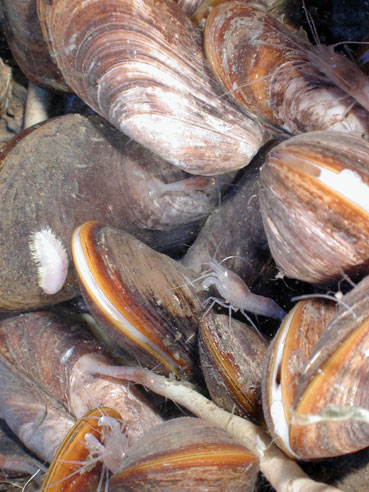Performing stable isotope analysis on representative samples from this mussel community will help scientists better understand feeding relationships between organisms. Click image for larger view and image credit.
These vials contain stable isotope samples from various organisms in mussel-associated communities in Walker Ridge 269 (WR 269). Further analysis of these samples will have to wait until the expedition has ended and the scientists have returned to their laboratories. Click image for larger view and image credit.
Who Is Eating Whom?
June 15, 2007
Erin Becker
Penn State University
27° 6.60 N
91° 9.93 W
![]() Shortly after Jason dive operations, the scene on the NOAA ship Ronald H. Brown fantail deck area can be best described as "organized chaos." (Quicktime, 920 Kb.)
Shortly after Jason dive operations, the scene on the NOAA ship Ronald H. Brown fantail deck area can be best described as "organized chaos." (Quicktime, 920 Kb.)
One important goal of ours is to better understand the interactions between different species, such as food web dynamics (who eats whom). These feeding relationships determine what species can or must co-occur, which species compete for food resources, and what is the primary source of energy driving a community’s food web. In seep communities, observation of feeding behavior or analysis of stomach contents is difficult because of the remoteness of the ecosystem and the tiny size of much of the fauna of interest.
In Gulf of Mexico seep environments, there are two major types of communities: tubeworm-associated and mussel-associated. These communities consist of the tubeworms or mussels as well as the smaller animals using the tubes or shells (and the spaces between them) as habitat. The associated fauna at these deep sites consists mainly of small animals such as polychaete worms, brittle stars, and shrimp. There are also a few larger species such as galatheid and brachyurid crabs.
A powerful tool for determining feeding relationships in these communities is stable isotope analysis. A stable isotope is a naturally occurring (but less common) form of an element that has more or fewer neutrons than the more common form. For example, carbon-13 (13C) contains one more neutron and is heavier than the more common, lighter form — carbon-12 (12C). So how do we use these isotopes to determine who’s eating whom? The key principle here is the ratio of the heavy (13C) to the light (12C) isotope in an animal. Since the ratio in the animal has a predictable relationship to that animal’s food source, carbon, nitrogen, and sulfur stable isotope ratios can be used to indicate food sources and trophic, or food web, levels. Carbon and sulfur isotopic ratios change very little from their food source and therefore are similar to an animal’s food source. The nitrogen isotopic ratio increases by a consistent amount with each trophic level and is used to indicate trophic level, such as primary producer, consumer, and top predator.
Erin Becker keeps careful record of which specimens she has sub-sampled. This sample log will prove invaluable after the cruise is complete and her stable isotope analyses continue at Penn State University. Click image for larger view and image credit.
Stable isotope analysis alone will not map out an entire seep-community food web, but it can point out possibilities. We must take into account the feeding capabilities of the animals. For example, if the isotope values show a sponge eating an anemone, we can dismiss this as a possibility since we know sponges feed by pumping water through their body and filtering out tiny suspended particles. Another limitation we must consider is the feeding morphology of an animal: does it have mouthparts and forelimbs for grasping prey, or mouthparts for scraping bacteria off a surface?
When we take all of this into consideration, stable isotope analysis is, indeed, a very powerful tool for describing trophic interactions in communities of animals in remote and hard-to-access environments, such as the deep hydrocarbon seeps of the Gulf of Mexico.


































